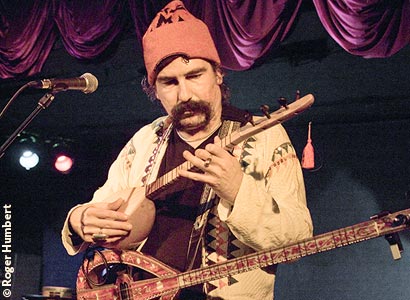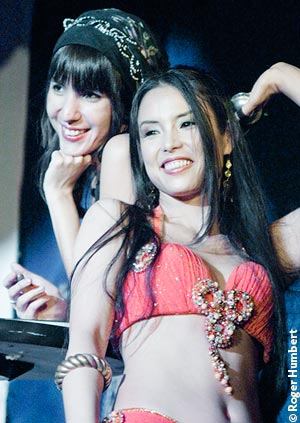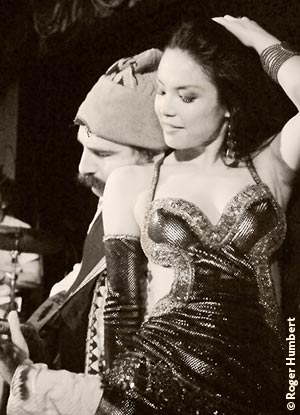 |
Baba Zula
at the 7th annual Small World Music Festival |
|
| September 23, 2008 • Lula Lounge • Toronto |
|
|
|
|
|
|
Baba Zula creates Hoopla at Lula
by Laila Boulos with photos by Roger Humbert |
|
Andrew Craig, of CBC Radio 2's Canada Live greeted the lively, percolating room laughingly noting that the crew at CBC Radio 2 still liked those in the audience who listened to CBC Radio 1. With a screen backdrop depicting the name Baba Zula under babbling brook waves, Baba Zula took to the stage amid the rippling of shouts and applause through the audience.
From the moment of their first joining of darbuka and saz, Baba Zula filled the air with mystical melodies flowing in and out as tides coming in to shore. Known for creating psychebelly dance music or oriental dub, their songs mix influences from the traditional Turkish folk music of the 1960s along with electronic and creative effects.
|
| During the evening, these special quirky effects displayed themselves frequently as one minute the sounds of horses would come galloping over the stage only to be overtaken by ducks quacking in a pond, which then gave way to the muffled sounds of footsteps crunching through snow. Baba Zula have also been known to use sounds of insects in their music and are recognized for making great use of the Turkish musical staple; spoons, in addition to the electric saz. The 'saz' or 'baglama' is a long-necked lute of folk traditions, and is the only electrified Turkish instrument. |
|

Murat Ertel |
|
|
Adding to the theatrical performance was drawing artist Ceren Oykut's deft use of Adobe Photoshop to bring to life the meanings of the songs. Her Etch-A-Sketch like drawings, although simple, conveyed deep meaning in terms of oppression and control as her artistic interpretations, in stark black and white, were magnified and projected onto the screen behind the band.
The extremely enthusiastic and vibrant audience almost appeared to be part of the performance as, throughout the evening, the women passionately belly danced and filled the air with ululations. Wedding wails, zagharit or zaghareet are referred to as ululations. These are vibrating vocals uttered by females expressing joy or grief; honouring someone; or, summoning people to belly dance (Middle Eastern dancing). These shrill ululations can be heard at festive occasions (like weddings) as well as funerals in the Middle East, India and Africa (where it is referred to as "ililta"). To get an idea of what this sounds like, listen to the beginning of the song "Wipe Out" by the Surfaris.
|
|
When singer Brenna MacCrimmon appeared on stage, the room erupted with shouts and applause. On "Cecom", MacCrimmon's haunting vocals were treated with echoed layering to create a beautiful sheer curtain of intoxicating vocals that flirted with the light energetic backdrop of the saz. On one piece, while singing, she skillfully handled the def, a Middle Eastern tambourine, to add whimsical effects as someone growled appreciatively from the audience, "You rock, baby!".
At many points in their performance Ertel related stories about life in Turkey, stating that he did "...not want to speak negatively about my country..." then adding that, "...the censorship committee banned our music not because of the music but because of the lyrics..." as the band jumped into a spacey piece of electronics. Meanwhile, Oykut skillfully drew a picture of a small animal that looked similar to a dog in a very restrictive cage while another animal in another equally restrictive cage reached over to console it. She later drew a two-headed monster, as the effect and power of the censorship committee was becoming clearer to the audience.
Throughout the performance, the cymbals were used liberally and contrasted with the primal power of the darbuka creating images of light against darkness and underscoring the mesmerizing timing of Turkish music. Speaking of timing, Ertel provided a brief lesson about the timing of Turkish music as he counted out one, two; one, two; one, two; one, two, three as he expressed his wish that the audience dream of this time signature that evening.
Once again, Ertel’s soul-drenching vocals, reminiscent of Dave Gahan (Depeche Mode), intertwining with MacCrimmon's Loreena McKennitt-like vocals provided a heady experience. Her Earth Mother expressiveness, and dream-like flow of warm energy created ecstatic chanting and envious shouts from the audience.
Later, Ertel held up a smaller saz connected to a mini amplifier distorting the sound as he turned the room into a rock concert stadium. Thankfully, the sound effects then changed to the wind whipping waves quickly over seashells.
Ertel stated that every country has its own (George) Bush to make people obey rules and so began a tongue-in-cheek song celebrating women's right to cheat. As the band continued their ode to freedom for adulterous women, suddenly, the aforementioned waves began to pound, crash against the shore as the thundering clash of cymbals meeting in the air battled with Akman's Jon Bonham drumming.
|
|

Ceren Oykut & Lale Sayoko |
|

Murat Ertel & Lale Sayoko |
|
|
|
As the belly dancer, wearing a sultry gold belly dancing costume, slithered and swayed, the band continued their Grace Jones' "Slave to the Rhythm" inspired intensity. The spoons, at Akman's hands tempered the intensity but it was short-lived as the band once again submerged the audience into the throbbing hold-on-to-the-headboard passionate rhythm. As the waves of distorted drums and psychedelic saz poured over the stage, the screen projection displayed an image of a mummy that morphed into a woman wrapped tightly in Muslim garb. The messages between the music and the artistically interpretive drawings, although conflicting, were each powerful.
Continuing their political and social commentary, Baba Zula began a song about Sheikh Bedreddin. Born of Muslim and Christian parents in the Anatolian city of Simav, Bedreddin was a philosopher and theologian who dreamed of a utopia where everyone in the world would unite. Dramatically, on the screen appeared a noose in which later was drawn a shepherd (read: philosopher, theologian) hanging, and a man with a gun behind him. Sadly, the censorship committee is continuing its legacy today.
Although the message in their final piece (and throughout the majority of their performance) was heavy, it did not deter the crowd's enthusiasm or desire for an encore, which they demanded with even more emotion than during the concert.
The encore of "Pirasa", with the cool intertwining of vocals between MacCrimmon and Ertel, once again, and Yes-style electronics satisfied the audience, especially when Ertel, without warning, jumped down from the stage, came out into the audience, and began charging up and down the room to the amusement of the onlookers. Still, after this display, it took a while before the room cleared, as everyone appeared to want to hold on to the magic of the Baba Zula experience.
|
|
A Bit about Baba Zula
A quirky name that fits their eccentric personas, Baba Zula means, in Native American, “great big secret,” which is similar to “Wakan Tanka” in Dakota mythology. In Turkish, Baba refers to “father” or “big thing” and Zula is similar to “secret”.
Turkish group, Baba Zula was created in 1996 in Istanbul, Turkey growing from the now disbanded Anatolian rock group, Zen. Their debut album, Tabutta Rövasata (Somersault in the Coffin) provided the original music score for Dervis Zaim's movie of the same name and was the reason for the formation of the band. Original member Emre Onel has since been replaced (in 2005) by Cosar Kamçi. Baba Zula was supposed to be a short-lived side project, but since their debut, Baba Zula has released a number of albums and worked with a variety of international stars in the music industry. Among their works are: 3 Oyundan 17 Müzik (Three Plays from Seventeen Pieces) on Doublemoon Records, which included music created for Antoine de Saint-Exupéry's classic, The Little Prince; Psychebelly Dance Music which was mixed and mastered by Mad Professor; Duble Oryantal, for which they worked again with Mad Professor, along with Alexander Hacke, Sly Dunbar and Robbie Shakespeare. They have also worked with well-known composers and lyricists in the world of Turkish music, such as Neset Ertas and Pir Sultan Abdal. The analog techniques of Turkish producer Mehmet Ates are also very much in evidence in their recordings.
|
|
Baba Zula
Murat Ertel – saz, other strings, vocals
Levent Akman – percussion, rhythm machines, toys
Cosar Kamçi – darbuka
Ceren Oykut – drawing artist
Lale Sayoko – bellydancer
guest
Brenna MacCrimmon – vocals
www.babazula.com
|
|
|
|
|
|




